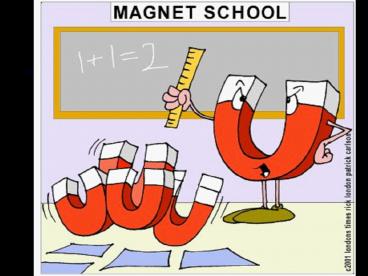Magnetism - PowerPoint PPT Presentation
1 / 25
Title:
Magnetism
Description:
Magnetism Children are fascinated by magnets! floating paper clip jumping nails iron filing cartoon hair magnetism Magnesia, province of Greece ... – PowerPoint PPT presentation
Number of Views:102
Avg rating:3.0/5.0
Title: Magnetism
1
(No Transcript)
2
(No Transcript)
3
Magnetism
- Children are fascinated by magnets!
- floating paper clip
- jumping nails
- iron filing cartoon hair
4
(No Transcript)
5
magnetism
- Magnesia, province of Greece
- Unusual property of lodestone noted over 2000
years ago
6
12th C, Magnets first used in navigational
compass, Chinese
7
16th C, William Gilbert
- Every magnet has two poles, a north and a
south. - Like magnetic poles repel, unlike poles attract.
8
Figure 5-3 A compass needle and the Earth. Any
magnet will twist because of the forces between
its poles and and those of the Earth. Every
magnet has at least two poles.
9
Courtesy Andy Washnik
Figure 5-5(b) Iron filings placed near a bar
magnet align themselves along the field.
10
Figure 5-4 A magnetic field. Small magnets
placed near a large one orient themselves along
the lines of the magnetic field, as shown.
11
Figure 5-5(a) A bar magnet and its magnetic
dipole field.
12
Opposites attract. Likes repel.
- The above describes both magnetic and electric
force, but - electric charges can be isolated,
- magnetic poles cannot.
13
Figure 5-6 Cut magnets. If you break a dipole
magnet in two, you get two smaller dipole
magnets, not an isolated north or south pole.
14
1820, Hans Oersted
- connected a battery to let electric current
flow, and noticed a compass needle twitch and
move.
15
Electricity Magnetism two sides of the same
coin
- Every time an electric charge moves, a magnetic
field is created. - (electromagnet)
- Every time a magnetic field varies, an electric
field is created. - (hydroelectic dams)
16
Electric motors convert electricity into magnetic
fields, for useful rotary motion
17
Figure 5-8 An electric motor. The simplest
motors work by placing an electromagnet that can
rotate between two permanent magnets. (a) When
the current is turned on, the north and south
poles of the electromagnet are attracted to the
south and north poles of the permanent magnets.
(b)(d) As the electromagnet rotates, the current
direction is switched, causing the electromagnet
to continue rotating.
18
Electric motors convert electricity into magnetic
fields, for useful rotary motion
19
Electrical Generators
- are the exact opposite of electric motors they
convert rotary motion into electrical energy. - link
20
Figure 5-10 An electric generator. As long as
the loop of wire rotates, there is a changing
magnetic field near the loop and a current flows
in the wire.
21
Anything that can turn an axle can power a
generator.
- Flowing water, pressurized steam, wind, or a
gasoline engine can drive a rotating turbine that
houses coils of copper wire.
22
Maxwells Laws
- 1. Like charges repel, unlike attract
- 2. There are no magnetic monopoles in nature
- 3. Magnetic phenomena can be produced by
electrical effects - 4. Electrical phenomena can be produced by
magnetic effects
23
James Maxwell in the 1860s
- was first to see that the four laws formed a
coherent system - realized that the four laws predicted the
existence of a new kind of energy
waveelectromagnetic radiation
24
Maxwell, in 1867, proposed that light is an
electromagnetic wave.
- The spectrum of visible light, from red to
violet, is only an octave or so in the range of
invisible radiations. There is a whole keyboard
of information all the way from the longest
wavelengths of radiowaves (the low notes) to the
shortest wavelengths of X-rays and beyond (the
highest notes) (Bronowski, p. 353).
25
Figure 6-11 The electromagnetic spectrum
includes all kinds of waves that travel at the
speed of light, including radio, microwave,
infrared, visible light, ultraviolet, X-rays, and
gamma rays. Note that sound waves, water waves,
seismic waves, and other kinds of waves that
require matter in order to move travel much
slower than light speed.































